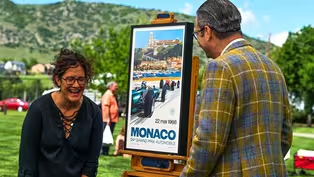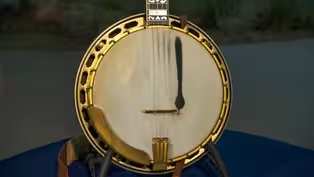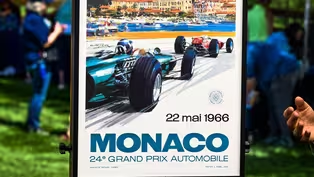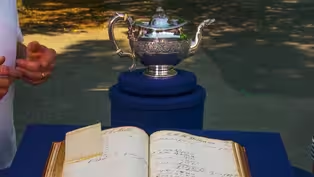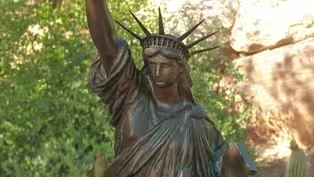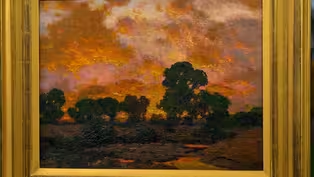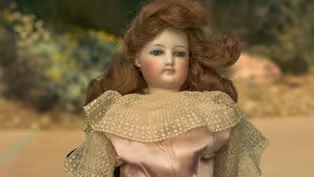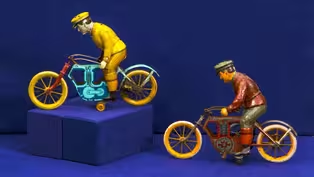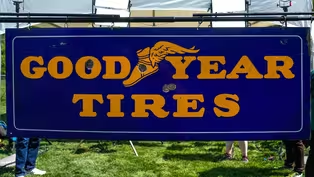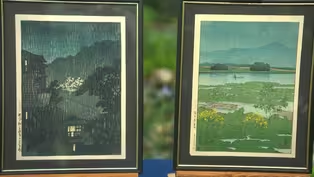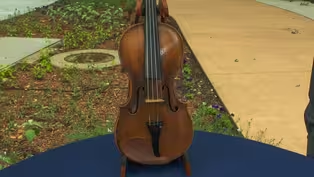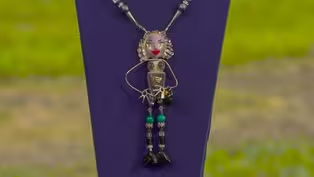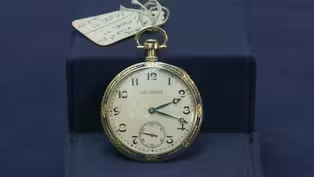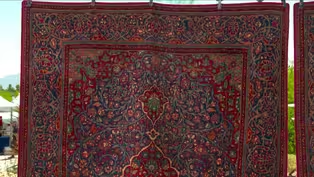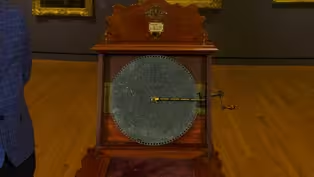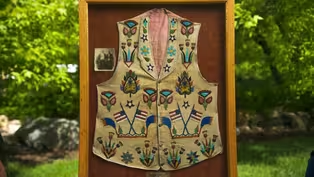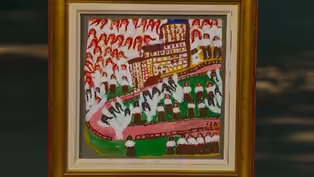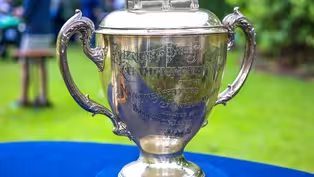

Junk in the Trunk 14
Season 29 Episode 25 | 52m 25sVideo has Closed Captions
Watch newly revealed treasures from all five stops of ROADSHOW's Season 29 Tour!
Watch newly revealed treasures from all five stops of ROADSHOW's Season 29 Tour, including a German tin toy motorcycle, a Babe Ruth exhibition card, and a Patek Philippe dress watch. Guess the big find from the Junk in our Trunk!
Problems playing video? | Closed Captioning Feedback
Problems playing video? | Closed Captioning Feedback
Funding for ANTIQUES ROADSHOW is provided by Ancestry and American Cruise Lines. Additional funding is provided by public television viewers.

Junk in the Trunk 14
Season 29 Episode 25 | 52m 25sVideo has Closed Captions
Watch newly revealed treasures from all five stops of ROADSHOW's Season 29 Tour, including a German tin toy motorcycle, a Babe Ruth exhibition card, and a Patek Philippe dress watch. Guess the big find from the Junk in our Trunk!
Problems playing video? | Closed Captioning Feedback
How to Watch Antiques Roadshow
Antiques Roadshow is available to stream on pbs.org and the free PBS App, available on iPhone, Apple TV, Android TV, Android smartphones, Amazon Fire TV, Amazon Fire Tablet, Roku, Samsung Smart TV, and Vizio.
Buy Now
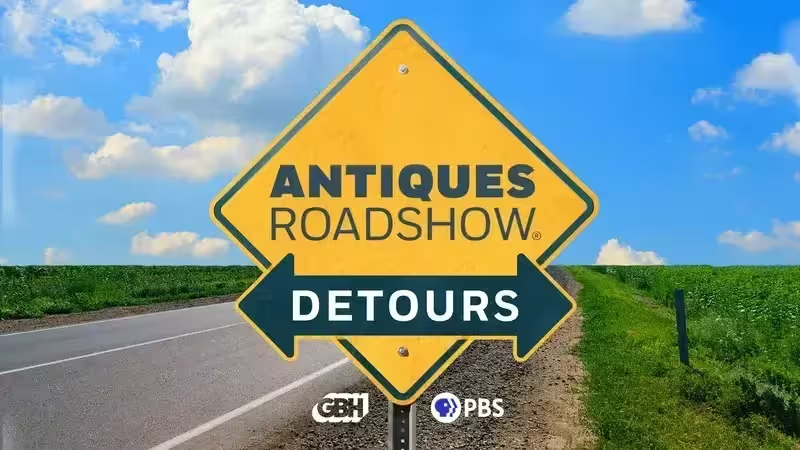
ANTIQUES ROADSHOW DETOURS
Ever wondered what happens to the treasures featured on America’s beloved ANTIQUES ROADSHOW after the cameras leave town? Host Adam Monahan tracks down the juicy afterlives of your favorite finds from PBS’s hit series.Providing Support for PBS.org
Learn Moreabout PBS online sponsorship♪ ♪ CORAL PEÑA: "Antiques Roadshow" is back...
I made a U-turn.
I said, "We got to get that sign now."
It's not something we see very often at all.
Oh, okay.
Wow.
(laughs) PEÑA: ...with another treasure-packed episode of "Junk in the Trunk."
♪ ♪ PEÑA: Harvesting even more of the great treasures we saw on our Season 29 tour, the Denver Botanic Gardens Chatfield Farms was blooming and beautiful as the backdrop for our stop in Colorado.
The story is it came across the United States on covered wagon.
PEÑA: As always, our guests had questions about their treasures and our experts weighed in to help set the record straight.
GUEST: This is a Goodyear Tire sign that I found in 1981 in Highland Park, Illinois, in somebody's garbage.
(chuckling): What?
And so, it was a cold winter day, we were on our way to church, and I saw this and I...
I made a U-turn.
I said, "We got to get that sign now, before anybody else does."
That's crazy!
So, we had a Chevette, and it barely fit inside the Chevette, and it's been in every garage that we've had since then.
That is the definition of a one man's trash is another man's treasure.
Yeah, yeah.
It is clear as day.
This is a Goodyear Tires sign, formerly known as the Goodyear Tire and Rubber Company.
They were founded in 1898 in Akron, Ohio.
Mm-hmm.
And before they became the powerhouse of road tires that we know today, they started out with bicycle and carriage tires.
The sign is enameled iron, and it is double-sided.
Uh-huh.
On the side of the back, identical image.
Trade term with the initials DSP, simply means double-sided porcelain sign.
It was really utilized in the 1880s, and they phased out enameled on iron signs once again to the late '40s into the '50s, because with World War II metal shortages, it really wasn't an economical way to produce advertising.
Yeah.
The enameling process, what happens is they take powdered glass known as frit, mix it with an oxiding compound and water, creates it into a liquefied compound.
Then, they put the stencil on, fill in the liquefied frit, put it in high temperature, bam, you got yourself an enameled sign.
In terms of condition, we do have some wear on the edge.
There is some minor oxidation, rust.
But overall, the general image; great gloss, great color.
It's an eight out of ten.
Uh-huh.
It's really beautiful.
It's a great sign.
We look at the bottom left, we see "Property, Goodyear Tire and Rubber Company."
I mean, it has all the marks that let us know this is as right as it gets, right as rain.
You ever have an idea of what it was worth?
Based on watching "Antiques Roadshow" and other car shows, I think $1,000.
You were probably watching a little bit of an older episode, because conservatively at auction, I would say this sign would easily bring between $2,000 and $3,000.
Wow, that's great.
And the lesson is, if you see something in the trash and you want it, just take it.
Don't worry about what people think.
(laughing) (chuckles) I like that.
That's great advice.
Don't be afraid to jump in the trash.
No.
GUEST: It's, um, an F1 poster, Monaco.
My husband and I bought it for our anniversary maybe five years ago.
Have you ever been to a race before?
(chuckling): We have, in Miami.
It was really hot.
(chuckles) (chuckling): Really hot in Miami.
And where did you get this?
I think it was Aspen.
How much did you pay for it?
I think it was $1,200, yeah.
You have to be like a really big Formula One fan.
Yes, to pay that much.
But we love it, and so we were willing to spend it.
The Monaco Grand Prix is the Grand Prix of Grand Prix.
Right.
Began in 1929.
Every year that the race was run, there was a, a poster advertising the race.
And beginning in 1964 to 1970, Michael Turner designed those posters for the race.
Michael Turner is a very accomplished and very famous automobile artist.
He's actually done posters for a number of different racing events.
He designed something for the Sebring race, uh, for the Deutscher Grand Preis, the German Grand Prix, and also for the United States Grand Prix, which was run in Watkins Glen up in New York State.
But perhaps his most endearing series were the posters that he did for the Monaco Grand Prix.
Oh, nice.
They depicted the beautiful Monaco scenery.
So this is the Prince's Palace up there in the port of Monaco.
And it should be said for those people who don't know about F1 racing-- and I'm one of those people, so I had to do a little research (chuckling) to figure out some of that F1 racing.
It's not like the Indy 500, where the cars go around a round track.
Right.
This goes through downtown Monaco, through the streets.
Super exciting, a little bit dangerous.
What's interesting about the 1966 race from a race history point of view-- the race was won by Jackie Stewart... Uh-huh.
...and they actually filmed footage from the race, uh, to make the movie "Grand Prix."
Oh, right.
So there's some footage there.
They were so popular, a lot of them were reproduced.
And a lot of the reproductions are on the market... Yeah.
...and they're available quite inexpensively.
Yeah.
It's very hard to tell which are the reproductions and which are the originals.
Yeah.
This one... Is a reproduction.
(chuckles) This one is original.
Really?
And I-I believe it's original because when you look at the text on the bottom where it says "Monaco 24th Grand Prix," when you look at that on the reproduction, it actually looks a little fuzzy.
It looks a little pixelated.
Mm-hmm.
And the rest of the image is also a little fuzzier.
So this one is really clear, and so I would consider it the real McCoy.
Okay.
If this were to come up for auction now, I'd estimate it between $2,500 and $3,500.
Oh, okay.
Wow.
(laughs) Nice.
Nice.
Wow.
And I said I wouldn't say "wow", (laughing): like everyone else...
I wouldn't say "wow".
Fantastic.
Thank you so much.
It's really-- wow.
Amazing.
(soft chuckle) It's from my husband's family from the Civil War.
It's from Joseph Matlock.
He was a sergeant with the Union Army, and it's been passed down from generation to generation of the oldest male.
So this was from, uh, seven generations ago in my family, from Maria Banks.
Maria was 23 years old and made this in 1845 in Meigs County, Ohio.
And it was the only thing that she took with her on a covered wagon when she and her husband moved to Iowa.
Came here today to see what it's worth.
GUEST: This has been handed down for generations.
There's a picture of my great-grandfather that's on it.
I acquired it in '79.
Is this him right here, in the vest?
Yes.
Do you know how he got it?
I do not.
I know that he was Sioux.
I know that he was in Rosebud and Pine Ridge, uh, at the time, in 1906, when this picture was taken.
My dad, when he had this framed, made that plaque.
The "Burning Breast" is something that he's always, in the family, called it.
It is Sioux.
It's from the eastern band, the Santee, by the Minnesota border.
The beads are hand-stitched on to what we call brain-tanned deer skin.
The vest is not a tribal design.
It's something that was picked up from non-Indians in the 1840s, 1850s.
But after 1870, everybody wanted a vest; Indian and non-Indian, and they wanted them beaded.
These are abstracted spring prairie flowers.
That's the reason I know it's Santee.
It's very particular to what they do.
You see it on a lot of their beadwork.
The flags, a lot of that was to recognize there was a dominating culture that they had to deal with.
Mm.
And you had a lot of military stations throughout those areas.
So, it was a good market.
The beadwork is one of the reasons we can date it fairly close.
These beads here, they're made out of metal.
They're faceted beads.
And they became popular in the late 1880s and pretty much died out because of supply after 1900.
If this was in a gallery, $6,000 to $8,000.
All right.
Yeah.
Nice.
Great.
And it's great that, that your family kept it so well.
Yeah, that's great to know.
GUEST: My husband and I love this painting.
We love the artist and we loved everything about the color in it.
How long ago did you acquire the painting?
It would have been about 40 years ago in the '80s from a gallery in Denver.
What do you know about the artist?
Well I just simply know that he was very prolific in Western art, and particularly, in Colorado.
Well his name is Charles Partridge Adams.
Partridge... yes.
And he was born in 1858 in Massachusetts, and moved to Colorado when he was 18.
His sister, I believe, had tuberculosis, so, you know how you would go to the mountains?
Oh yes, oh yes.
And he started working at a bookstore called Chain and Hardy, and the wife of one of the owners had actually studied with George Inness and when she realized that he had artistic talent she very much encouraged him and supported him in his quest to become an artist.
He had his first exhibition in Denver in 1886 and established his first studio in Denver in 1893.
He also started spending the summers in Estes Park and painting there.
And one thing he figured out when he did establish a studio was that if he painted in watercolor, those paintings tended to sell a little bit faster because they were less expensive.
So he was-- he was very clever.
He moved to Los Angeles around 1920 and basically lived there 'til he died in the '40s.
But he-- again, being clever, he figured out that the Colorado subjects that he liked to paint didn't really sell so well in California, so he started to paint coastal scenes.
But he would still paint Colorado subjects from memory and send them back to Colorado for sale.
So he was quite entrepreneurial.
He was very, very prolific and very popular.
Yes.
Here.
This is a very good example of the artist's work.
A circa date might be 1900 to 1920.
The medium is oil on canvas.
What I particularly love about the painting, like you, is the color, but I also just love looking at the surface, where you can see the texture of the paint...
Yes.
...and the mark of the brush.
I know we talked about maybe how much you paid for it.
I just can't really remember, but I'm guessing $20,000 to $25,000.
Well that would make sense, because in the late '80s, the Western market was very, very strong...
Yes.
...and there were very good prices then.
Yes.
If we were to offer this in a retail gallery now, the asking price might be around $50,000.
Well that's always encouraging and nice to hear, but I love having it in my own house.
I love showing something as beautiful as that, and 'cause I adore Colorado.
♪ ♪ PEÑA: Las Vegas was a hot spot for great stuff when more than a couple thousand collectors brought their art and heirlooms to Springs Preserve.
Some treasures had our experts a bit puzzled.
It's-- it's a pretty wild piece.
I'm not sure I'm going to be able to answer your, your mystery, though.
We've been in this business a long time and haven't seen one of these before, so that-- that's one of the fun things about... Stumped the appraisers!
On of the fun things about... You guys get the prize.
PEÑA: While other antique gems were easy to identify.
APPRAISER: Mikimoto was the most popular pearl retailer from Japan, and so this takes after Mikimoto.
They're not as good quality as Mikimoto.
PEÑA: What else did "Roadshow" find in this desert oasis?
Check it out.
GUEST: I got her when I was ten years old.
It belonged to my great-aunt, and she said that a relative of hers was a lady-in-waiting from Louis XI or Louis XIV.
I never knew for sure, and that it was handed down in the generations through her family.
So at ten years old, were you allowed to play with her?
No.
What happened to her?
My mother wrapped her up and put her in the attic.
(laughs) Oh, the dreaded attic.
And I didn't get her back until my mother passed a few years ago.
Your doll was made by François Gaultier, in the southern part of Paris in France, and it's a bisque swivel head.
That means that it's in a shoulder plate, and you can actually turn the head back and forth, so you can pose her in her beautiful gown.
And then she's got a kid leather body.
Right.
I believe you told me that your aunt made the gown in France.
Oh, yeah.
Can you tell me about the wig?
Ah, well, I was ten years old, I thought I would be playing with her... (laughs) ...and my grandmother says, "Well, let's put some hair on her," and we dropped her off in New York and this guy put hair on her and offered me $150 for her, and that's probably why my mother took her away.
(laughs) (chuckling): Okay.
Original wigs, even in just horrid condition, always are better.
The little part of the story that's not matching up is this doll was made in 1870s.
Ah, so...
So that doesn't match up with Louis XIV.
This is a very popular doll, and they sell between... today's market, about $1,200 to $1,800 retail.
Ah, okay.
All right.
I don't think I'll be selling her.
If she had the original wig, we probably could add another $200 to her value.
Ah, yeah.
I acquired them from my grandparents through my father.
I've had them for about 15 years now.
These were purchased by my grandmother in the 1930s as antiques.
Okay.
Um, she was an antique collector.
What you have brought in today is a pair of Persian Kashan rugs.
Kashan is a weaving center in central Persia.
It's been actively weaving rugs since the 16th century.
These examples were woven around 1925 to 1930.
Okay.
So when your grandmother purchased them, they were close to being new.
Earlier Kashan rugs used a different type of wool, they used Manchester wool.
It has a different feel than the Persian wool which followed it... Mm-hmm.
...which has got a little bit of a slightly rougher feel.
Mm-hmm.
Kashans from this period, the 1930s, have these central pendant medallions, complementary spandrels, and floral borders.
Do you have any idea what the value would be of these rugs?
I don't.
Probably a couple hundred dollars each.
For these two Kashan rugs, in auction, you could expect to get a value of $2,500 and $3,500.
Wow.
(no audio) GUEST: I got it five years ago.
My daughter and I were driving around, we came across this yard sale.
It caught my attention, because... the size.
Uh-huh.
This is the lady of liberty.
And how much did you pay for it?
Um, I paid $200.
Her official title is, uh, "Liberty Enlightening the World."
Oh.
And it was a gift from the French people to the United States.
Oh, okay.
And the French gave the sculpture, and the Americans had to raise the money to build the platform.
And it was meant for the centennial of the United States.
Over here it says July 4, 1776. so the original one, the big one in New York City, is made out of sheets of hammered copper, and the structure that supports all of these sheets was designed by Gustave Eiffel.
He's the one who did the Eiffel Tower.
Uh-huh.
This is supposed to be, uh, rays of the sun.
You're-- you're missing one here.
There's supposed to be seven, yeah.
Yeah, I know.
I know, there...
So, it's supposed to be seven, and also they think the seven could represent the seven seas or the seven continents.
Oh, okay.
Which is very appropriate for immigrants coming... Oh, yeah, yeah.
...to the United States.
They were originally made in the 19th century, and they came in different sizes.
It's inscribed here: "Registered in Washington, 31 August 1876.
"Bartholdi, number 99396, 1875."
So it was registered in the United States copyright office.
It's a bronze.
The original ones were made in zinc.
So somebody made a cast from one of the zinc ones and made it in bronze.
When you do that, some of the detail gets lost, and that's how I know that it's not an older one, 'cause the details are not as sharp and as crisp... Oh, okay.
...as an original one.
I don't know how old it is.
it looks like it could be 50, 60 years old.
Avoiron, they're the company that made the one in zinc, and we know that-- that they didn't make this one, because they didn't make bronzes.
It's still very nicely cast.
The details are good.
So this would have a retail value of about $5,000.
$5,000.
Okay, that's good.
Great.
GUEST: I got it at an estate sale, and I went for a Selmer saxophone.
It was already sold, so I ended up with a Martin Imperial trumpet from the 1930s.
I have no idea what it's worth, and I can't play the trumpet, so here I am.
GUEST: This is a pension Revolutionary War certificate to William Knapp, who's a great-great-great-grandfather of my husband.
It was signed by John C. Calhoun, and this is how much he's going to get paid for being in the war.
Eight dollars per month.
GUEST: I studied banjo all through high school.
When I got out of high school, I ran away to be a musician, and I came across this banjo in about... ooh, 1979, 1980.
I just loved the sound of this banjo.
The neck, I wasn't so sure about.
I'm still not so sure about, as far as being original.
But I just loved the sound, and I played it hard for a good ten or 12, 13 years at bluegrass festivals, clubs.
And unfortunately, I cannot even remember how much I paid for it.
Maybe $3,000.
Might have been as much as $5,000.
This is a 1929 Gibson Mastertone banjo.
We took the back off, we looked at the serial number.
Firmly 1929.
It has gold hardware.
It has a beautiful flame maple back.
It's so well-played.
It's got the patina of an instrument that has been loved and well-used, which I love to see.
I'm so glad that you didn't polish off any of that.
(laughs) Originally, this would have come with an arched tone ring, but it's been replaced on this for the much preferred flat top.
Now, when you brought up the neck, you are correct that this banjo has been re-necked at some point.
This model would have originally come with a rosewood fretboard, but we can clearly see that this is ebony.
We can also see that the mother-of-pearl inlays have been harvested from that original fretboard and then kind of crudely put back in this one.
If you get up close, you can see a lot of, uh, squeeze-out from the glue, wide channels.
Now, in its current condition, with a replaced neck, likely happened sometime in the 1970s.
Mm.
This banjo, in a retail setting, is worth about $5,000 to $6,000.
Woo-hoo!
(laughs) Yippee!
(laughs) Worth the world to me.
It's like my old buddy.
PEÑA: The day began with rain at Crystal Bridges Museum of American Art, but it didn't stop hardy treasure hunters from coming to "Roadshow."
The cameo is made out of shell, and it's carved in Italy.
In Italy.
Oh, this is great.
It is great?
Oh, good!
(laughs) PEÑA: When the sky started to clear in this thriving corner of Arkansas, our cameras were ready to record.
GUEST: It came from my wife.
It was a gift from her father, who purchased it in Chicago in 1955, and my understanding is that it was a piece of equipment from a Georg Kloz, part of the family from Mittenwald, Germany.
I would like to get a verification that this is indeed a Kloz violin, and not a copy.
There is a... a paper signature in... within the violin body.
They can be messed with, they can be changed.
And it had a date in there, and the date was somewhere around the 1765, '66.
I never look at labels whenever I appraise an instrument, because they can be taken out, they can be changed, or they can be in there from the time the instrument was made and just be fake.
The top of the violin is made out of spruce.
Uh, the ribs and the back are made out of maple.
The first thing I look at for an instrument from the 18th century is I look to make sure that the scroll has been grafted, and this one has.
That's great.
The Kloz were a family of makers out of Mittenwald, Germany.
The Mittenwald makers made their instruments using an outside mold versus the Cremonese, who would often use an inside mold.
So where the ribs join at the corner, because they used an outside mold, the joint, instead of being like right on the corner, is actually slightly on the inside, towards the center of the c-bout.
Kloz family instruments will have a one-piece rib.
A lot of violins, they-- they have a joint right here.
So normally there's a line right down the center here, but there isn't one.
It's all one solid piece, and then there's this little notch carved right there that lines up with the back seam.
Another Kloz attribute is that the fluting of the scroll actually, instead of stopping right here, will continue on all the way up the mouth of the scroll.
And this one does.
The thing for me is that it-it doesn't quite look 1760s.
Still definitely, I would say 18th century.
Okay.
Um, but a little bit later.
Later.
I do think it is Kloz family, but I-I don't think it is by Georg.
The Kloz family, there were many, many makers.
I would feel comfortable saying that this instrument would sell for $15,000 in today's market.
Thank you.
I-I was hoping for a definitive Georg Kloz creator, but we'll keep it in the family for a long time.
GUEST: This card belonged to my great-great uncle, (chuckling): who was a Polish immigrant farmer in Southeast Missouri.
Never married, never ventured much out of Missouri, except for a trip to see the St. Louis Cardinals when he was a young man on the train.
My parents were helping clean up at an auction after his death, and my dad went up into the attic to make sure there was nothing else left behind, and he saw a folded up paper sack stuck in the rafter of the attic (chuckling): of this old, old bachelor farmhouse.
And inside it was this, and a couple of other of the exhibition cards.
So what year was this?
Late '80s, early '90s.
We're looking at a 1928 exhibition card of Babe Ruth playing for the New York Yankees in the prime of his career.
So this was made by the Exhibition Supply Company.
It was actually sold in a penny arcade in a vending machine for a penny.
What makes these exhibition cards different from tobacco cards and bubblegum cards is one-- they're much bigger.
This was not selling anything.
Early baseball cards sold bubblegum or they sold tobacco.
But this, you could buy a card on its own.
These cards were made in a lot smaller quantities than the others, so there's very few of them that exist today.
Oh.
In fact, we only know of, say, about 30 of them that have been graded.
I'm not a professional grader, but looking at the card and seeing just a little bit of wear on the edges, I would probably grade this about a five out of a ten.
That's the highest grade known for these Babe Ruth exhibition cards.
Oh, that's exciting.
Which is very cool.
Collectors really were not interested in these cards for a long time.
They preferred the tobacco or baseball, but now they've become more popular over the last two to three years.
Awesome.
This card, in this condition, I would put an auction estimate of $6,000 to $8,000.
(laughing): Wow.
Oh, my gosh.
(laughing): Good old Stanley would really love that.
This is a Chinese scroll that my sister gave to us for a, a wedding anniversary present, and I don't know exactly how old it was.
Somebody said it was 1700.
It's got some stamps and some information on it, so we're hoping to find out more detail about it.
GUEST: It's a old Regina original jukebox.
Put your nickel in, and it'll play the songs, and you get one song for a nickel.
And I've got about maybe 20 different songs that'll load up.
So, uh, but I haven't been able to find this one on the internet, so I'm hopefully-- y'all can shed some light on what I have.
I was so excited when I saw you walking across in front of my table with this, and I overheard you say, "Nobody knows what this is," and I shouted out, "I do!"
(laughs) It looks just like a small slant front desk.
Mm-hmm.
However, it's a music box.
It's been in our family since 1957, and we actually have the original receipt from the seller, who was an elderly lady.
She sold it to my stepfather.
The Regina Music Box Company was founded by a man named Gustave Brachhausen in 1889 in Germany, and within three years of founding the factory, he had expanded to Jersey City, New Jersey in 1892, where he began making cases for the parts for the insides were still being imported from Germany.
Within just a few years, all of the operations were made in New Jersey, but in a larger factory in Rahway, New Jersey.
This stylistically does date from the late 19th century and probably this case, and all of the works, were made in that Rahway, New Jersey factory.
In the late 19th century, people loved things that were whimsical and sort of secretive, and this you would not have necessarily known that this was a music box if you just walked into someone's parlor and saw it.
I searched through lots of records to try to find examples of this... (soft chuckle) ...and I could not find this exact model anywhere.
So I think it's probably-- Could be a good thing.
I think it's a good thing.
I think it's probably a very rare example; now, the downside is that the music box market is, uh, not especially robust at the moment.
I wouldn't think that's a hip thing to have in your house right now.
Yeah.
The generation that was interested in those has aged out of the collecting phase of their lives... Mm-hmm.
...if they're even still here.
In the current market, this being such an unusual example, I think, realistically, you could put a, uh, $4,000 to $6,000 estimate maybe even a $5,000 to $8,000 auction estimate on it.
Fantastic.
Because it is such a rare example.
That's fantastic, I appreciate that.
So you think you want to crank it up for us?
Yeah.
And see how it sounds?
Let's, let's, let's, uh, give it a little whirl, so to speak.
Let's see what it sounds like.
(music box playing) GUEST: My grandfather was a jeweler watchmaker here in Arkansas and I inherited this.
It's the finest maker, Patek Philippe and Company.
And on the dial of the watch, everything is fully spelled out.
"Patek Philippe and C-O, Geneva, Switzerland."
After, they started to abbreviate it and they would just say "Patek Philippe, Swiss."
Mm.
Mm-hmm.
So that's one factor that is desirable.
The other, of course, is the enameled case.
You have a beautiful yellow gold case in 18 karat with blue enamel trim on the borders and then on the monogram on the case back.
The watch itself is a typical man's dress watch that was made in the 1915 to 1920 period.
It's in very good condition.
It is running and operating as it should.
Mm.
An auction value, of this watch would be estimated in the $5,000 to $6,000 range.
Retail, $6,000 to $8,000.
Okay, thank you.
GUEST: My great-grandfather was a amateur pocket billiard champion in the early 1900s.
This is a trophy from one of his championships and then this is a sketch done by a cartoonist in Cleveland of my great-grandfather, uh, J. Howard Shoemaker.
How many of the amateur national championships did he win?
He won 17.
My understanding was his first tournament that he won was in 1913... Mm-hmm.
...and he was active all the way through 1937.
The trophy is identified as the amateur pocket billiard champion.
Exactly.
Dated 1912.
At this time, it was more commonly called pocket billiards.
We now call it a game of pool.
This particular trophy is sterling.
The trophy is created by the Whiting Manufacturing Company and they were in New York at this time.
It has the Whiting hallmark and the sterling hallmark underneath the lid.
It's also marked on the base as well.
What really puts it over the edge for me is the actual pool table that's on the top.
That's my favorite part of the trophy.
It's just unbelievable craftsmanship.
With how expensive it would have been to have this trophy made, it shows how respected and how popular this tournament was, even being an amateur tournament.
We see that it's awarded to another gentleman in 1912, and then your great-grandfather won the tournament in 1913.
And then it shows there was no tournament in 1914.
And then he came back the next year and won it for a second time.
Because he won the second championship, they actually gave him the trophy.
He had to play the other player... Mm-hmm.
...before he could have the trophy to keep for... as a personal property.
And with all those wins he had as an amateur, what's become of the rest of the trophies?
My grandfather, when silver prices were quite high, he melted down most of the trophies.
Mm.
That was not uncommon at that time when we had that spike with silver.
I believe it was in the 1980s.
Mm-hmm.
And there were people that were melting silver as fine as Tiffany silver and things like that.
Oh, my.
And you brought the drawing, which is an original newspaper art... Mm-hmm.
...illustration of him at the pool table, done by an artist named R. Grove of Cleveland.
The newspaper illustration is a great complement to this, that would sell at auction for $200 to $400 for the illustration.
(gasps) Oh, my.
Okay!
The trophy itself is fantastic.
For them to commission to Whiting a sterling trophy of this magnitude is not something we see very often at all.
Really?
Yeah.
This trophy, at auction, would sell for $12,000, up to $16,000.
(chuckling): Oh, my goodness.
Wow!
That's amazing.
Oh, wow.
PEÑA: Living History Farms in Urbandale, Iowa had rows of treasures and eager guests ready to hear from our knowledgeable appraisers.
Pardon me?
It's a lithograph.
Okay.
So it's not a print of a print.
It's a real print.
Okay.
APPRAISER: The cobalt blue enamels.
We don't see that very often.
Mm-hmm.
This is really fancy.
PEÑA: What other fancy finds made it to "Roadshow" in Iowa?
GUEST: This clock is, as far as I know, at least 50 years old.
I first saw it in 1968.
My first wife's grandmother owned it.
She always referred to it as "my Russian clock."
How long have you owned it?
Oh, I've had it over 40 years.
40 years.
Yeah?
Yeah.
And have you ever seen it working?
No.
I have not.
It's actually an American clock.
It was made by the Ansonia Clock Company in Brooklyn, New York.
Common versions look like buildings.
This would be more of their fancier version, for sure.
Uh, much more complex in this design.
The Ansonia Clock Company made a line that they called Swingers.
And it gets its name because when this clock's operating, this pendulum moves back and forth like that.
Now, you say that it's not working, but I understand that you don't have a key to wind it.
No.
And I bet you if you wound this, it would actually operate.
This particular figure is Fortuna, goddess of fortune.
And she's one of a series that Ansonia made.
She is the largest of the group and features the larger ball, four-and-a-half-inch ball, and she was made circa 1900.
The mechanism is actually enclosed in there.
Some people call these mystery clocks because the mystery is how does it actually work if it's moving back and forth?
It's a fantastic example.
The statue itself is a combination of bronze and there's probably some white metal.
It has a patinated finish on it, which is in very good condition.
The ball is-- are brass.
This is actually the original color here.
This one's been cleaned off.
This is the hand that belongs on the face and it has been broken.
This is not a big deal in terms of restoration.
Oh, that's good.
That's good news.
In today's market, this clock would probably sell somewhere, uh, in a retail setting, in the $3,500 price range, but because it needs a little bit of work, the wholesale price for, uh, something like this in an auction setting or at a wholesale setting in a shop, uh, would probably be in the, closer to the $2,500 price range.
Oh, that's excellent, that's excellent.
Now that you've got... told me that it would be easy to fix, I'll have it taken care of and put it back on the shelf and display it proudly.
GUEST: I acquired this piece at an estate sale.
There was a lady in our hometown who had lots of things and she had a huge estate sale.
My sister and I went there and we left there with ten items for $100.
So ten dollars apiece.
This is what we call artisan craft jewelry.
If we flip it around here, we can see that it has a pin so you can wear it as a necklace or a pin.
The piece is signed, Laura Stamper.
Laura Stamper is an artist that is still working today.
A lot of her pieces were made in the '90s like this particular one.
It's jewelry, but it, it's really art.
It has a lot of whimsical features.
The material, you have sterling silver, you have gemstones, glass, hand-painted porcelain.
The piece has pyrite inclusions, which look like gold.
These pieces are probably recycled from other pieces of jewelry.
Collectively, they may not be worth much, but as a design, as an art piece.
If it were to come up at auction, I would place an estimate of $800 to $1,200.
Oh, wow.
If they were to be offered in a retail setting, it could possibly be priced at $1,500.
Wow.
That's very surprising.
This is a, uh, clock that I got at an auction for my mom-- she's a Coca-Cola collector.
I paid $40.
(chuckling): I have no idea what it's worth.
GUEST: It was a housewarming gift from my best friend's mother.
She got it at a thrift store for seven dollars... For s-- ...in southern Iowa.
So what we have here is a mirror by a Hungarian-born artist by the name of Paul Kis, who came to prominence in France in the 1920s and 1930s.
What we really love about this mirror is that it's really in original condition.
Your condition's kind of rough, but it's original condition.
And if I were going to see a mirror like this in this condition come up for auction... Mm-hmm.
...I'd expect to sell for around about $1,000 to $1,500.
Wow.
Interesting.
GUEST: I brought in two vintage motorcycle toys that my husband, who passed away seven years ago, had, um, in our home.
I don't know where he got them from, exactly.
It's been probably over 20 years.
I mean, he's been collecting for a long time.
He went to different, um, events and flea markets and stuff, so I don't know exactly where he got these from.
(laughs) They're both German-made, and they are beautiful examples, all original and authentic, which is hard to find.
They are tin toys that are covered in lithography.
If you look at the sides of the bikes, the tin work is almost identical with the cutouts... Mm-hmm.
...on each side of the bike, but they have a very big distinction between the two, uh, which is the way they're powered, the way they're wound or motorized.
Uh-huh.
On this bike, there is a wind-up motor on the rear, which is a simple spring.
Mm-hmm.
On this one, it's actually a hand crank that drives a friction wheel.
While both are scarce bikes, this one we deem is rare.
Mm.
It does not turn up very often in the open markets and is extremely desirable.
The other nice thing about these motorcycles, as opposed to some of the other toy bikes, is that they were made in Germany, so we have an international market participating for these bikes.
Whereas if they were American-made toys, the core market would be here in the States.
So there's a very wide audience for these motorcycles, making them quite valuable.
Hm, that's interesting.
This one at auction would be estimated from $3,000 to $5,000.
Hm.
This one, at auction, would be $5,000 to $7,500.
Oh, really?
That's great.
That's great news.
Would you mind if we wound this one?
No!
Give it a... give it a try?
It's great that that even still works.
(chuckles) PEÑA: When "Roadshow" ended our season tour at the Maryland Zoo, the animals weren't the only curious observers of the art and antiques that arrived for inspection.
One collection with Baltimore history wowed our appraiser.
This is the account book for Andrew Ellicott Warner, one of Baltimore's early silversmiths.
And apparently, he kept in the shop a inventory.
As people came into the shop and ordered things, he wrote it in the book.
He also recorded the weight of the piece.
And then when it was finished, he checked it off as being picked up and paid.
The pot has descended in the family.
And the family has said that it was Andrew Ellicott Warner's own teapot.
In Baltimore during the time period of that 1810 to 1880 period, you had two prominent silversmiths.
You had Kirk and you had Warner.
This is all of the sales from 1839 to 1860 that the company A.E.
Warner Silversmiths in Baltimore had done.
Being able to see the actual copy of the sales book for Warner for a 20-some year period is, for a silver collector-- and I'm a crazed silver collector-- is-is ridiculous.
Every last name of a prominent Baltimore family, a street, a county, is in there.
The one I have open to is Charles Ridgely.
The Ridgely family had Hampton, which was the largest home in the United States in the 18th century, and the father was the governor of Maryland.
As it turns out, as we were looking through, I have the silver tea waiter, 189.5 ounces, for $473.12.
And I have that in my own collection, that's listed in the book.
So I was absolutely going crazy when I saw that there's the original sales journal for the Williams tea tray that's sitting in my dining room right now.
The teapot is an Empire Rococo style.
This is pre-1814, because in 1814, there was a law in Maryland.
It was called the Assay Law, which meant that in Maryland, they would collect a duty or a tax on the amount of silver that the silversmiths used during that year.
Mm-hmm.
So the Empire Rococo period in Baltimore started probably in that 1810 to 1813 range, and then it became Assay.
So the mark on here is a pre-Assay mark.
It's beautifully done.
You've got the serpent in the spout.
The handle is also a serpent with tail, and there are ivory joints to insulate it so that it would be not super hot if somebody was touching it.
Because of the age of the piece and the fact that the ivory has that yellow hue and has very old striated cracks, this would have no problem with the post-banned ivory issue that exists today.
This is 150-year-old ivory or so.
The pot being, by descendant in the Warner family, to any Baltimore silver collector, and there are quite a few, wo-- this would be a crown jewel for most people's pre-Assay collection, and having a-a family pot would be pretty valuable.
This would probably sell at retail in the $3,500 to $4,000 price range.
Okay.
The sales book, all the information about all the items, the weight of the item, the date that it started, the date that it finished, what it cost in 1840 or 1850...
Right.
...is just invaluable to silver collectors.
I conferred with another colleague, and we came up with a price of somewhere between $8,000 to $10,000 for the book.
Wow.
Um, for a collector like myself, this is like heaven.
I'm-- I was thrilled to see it.
So pleased you could enjoy it.
(laughs) GUEST: My wife and I were shopping at a local flea market just for odds and ends.
We walked up to a table, and it was just sitting there.
And I was able to negotiate for five or six different items for like five dollars.
I recognize it as being Slavic, or at least the-the letters, um, but I couldn't read it.
Uh-huh.
Right.
Uh, so I-I did recognize the George Orwell with the pig, and I assumed it was "Animal Farm."
It is "Animal Farm" by George Orwell.
And it's the Ukrainian edition.
In fact, it's one of the very earliest translations that was made of the book in 1947, and it has a curious history.
One of the publishers in Ukraine got a copy of the English edition from 1945 and read it out loud to displaced persons in Ukraine; did a translation on the fly; and they were so impressed they decided they needed to do a publication and wrote to Orwell, who immediately agreed to authorize a translation.
And actually produce a special preface in this copy, and in this edition alone, where he accounts the reasons why he wrote the book and the-the background for his inspiration.
He had been in Spain, and he was thinking of a way to try and capture the challenges of totalitarianism and Stalinism that was emerging, and he felt he needed to have a story that was easily comprehensible by almost anyone.
And he had seen a-a young ten-year-old boy whipping a horse in the middle of the fields in Spain and thought, wouldn't it be unbelievable if these animals could rise up with their strength against the oppression they felt?
And he thought it was the perfect parable for Stalin and totalitarianism to come.
Mm-hmm.
So the book was printed in Munich for the Ukrainian publisher in an edition, we believe, around 3,500 copies.
But the Ukrainian authorities confiscated at least 1,500 of those as they came into the country, because the Ukrainian authorities were, under the Soviet regime, were afraid of people reading this book.
We believe about 2,000 were distributed to so-called displaced persons who were fighting against the St-Stalinist regime.
Because it's a very limited number that survived, the value of the book is, for an auction, about $1,000 to $1,500.
Mm-hmm.
I went in the Salvation Army and I just saw it there.
With tax, it come to $42.
It was made in 1936 for the American Brewery, which isn't far from here, in Northeast Baltimore.
The story I heard is that it had four half-gallon bottles, and so they made these boxes to carry them in.
But back then in 1936, people just had little ice boxes in their home.
Since the beer wasn't pasteurized, it had to be kept cold at all times.
So people didn't have room in their little ice boxes for these big half-gallon beer bottles.
And it-- I think it was a flop as a result.
GUEST: This is my grandmother's doll.
And she purchased it in the '90s.
She kept it on her mantle, and she always said it was a spec-- her special doll.
It kind of reminds me of, like, a Kewpie doll, but I don't think that's what it is.
It's interesting that you say, "Kewpie doll," because a woman named Rose O'Neill illustrated the Kewpie dolls.
And then they started making dolls of the Kewpie dolls, and it started an entire industry of what we call character dolls.
And little Kewpie dolls had eyes looking to the side, and so other companies started making dolls with eyes looking to the side, and they've been nicknamed as Googly dolls.
The doll is a Hertel Schwab doll, which was a German company.
The doll was made in the 1920s.
Oh my goodness.
This is a particularly rare character doll, because it has the molded hair and the molded tufts of hair on the sides.
On the back of its head, it has the numbers, "172-6," which was the model number for this particular head.
The head is made of bisque, and bisque is the-the term we call porcelain; it's not glazed with a shiny glaze.
It's airbrushed with a color, and then all the detail is painted on, and then it's re-fired.
He's on a toddler body.
The clothes have been made, probably, in the last 40 years.
The original clothing to a doll like this would be very simple, a little cotton romper suit or something like that.
Okay.
Oh, okay.
An auction price... Mm-hmm.
...it would probably go for between $3,000 and $5,000.
Oh, my goodness.
(both laugh) Wow.
But, uh... I-I had no idea.
I thought maybe $150.
(laughs) GUEST: This is a painting by a street artist, uh, from New Orleans.
Her name is Sister Gertrude Morgan.
She was very spiritual, and she expressed her spirituality in her artwork.
When did you acquire this?
I purchased it for $45 in 1973 in New Orleans.
I was there for a conference, and I was walking around the, um, French Quarter, and there was a gallery that, uh, was showing her work.
And what was the name of the gallery you bought it from?
Uh, Borenstein Gallery.
Larry Borenstein had a gallery in the French Quarter.
His gallery championed Sister Gertrude Morgan's work, and eventually his gallery became Preservation Hall.
Yes, exactly, yes.
So, very, very famous location.
Mm-hmm.
Sister Gertrude is born in 1900.
She comes to New Orleans in 1939.
She is a Black American that becomes a preacher, a philosopher, a musician, a poet and an artist.
And this is one of her paintings.
As you said, they have a religious tone to them.
For Sister Gertrude, this is actually one of her larger pieces.
Mm-hmm.
It's a very nice-sized piece.
It's fully developed, and when we look at it, we see what she usually tries to work into some of her paintings.
Sister Gertrude is up in the upper right-hand corner... Mm-hmm.
...and she's standing there reaching out and holding hands with what most people think is either God or Jesus.
Right.
That she's marrying, and we see angels, and then we see this kind of structure, and that's her New Jerusalem.
And it's an oil painting, and she did it on a paperboard.
On the back, is the $45 price tag...
Right.
...that you paid, and we see a wonderful black and white photo of Sister Gertrude.
Yes.
It's a wonderful, wonderful artwork.
Thank you.
And, um, in terms of valuation, what do you think it's worth in today's market?
I would say maybe $500.
This I would place, for sure, in the top 20% to 25% of her entire body of work.
Oh, wow.
It has all the pluses.
You purchased this from the Larry Borenstein Gallery.
That's a gold seal of approval.
So in today's market, retail, I really have no problem saying this is somewhere between $15,000 and $20,000.
(laughs) Wow.
(laughing): Well, thank you.
That is exciting and very interesting.
Thank you.
PEÑA: And now it's time for the "Roadshow" Feedback Booth.
We came from far and wide to wow the appraisers with, uh, fish tales and stories of precious silver soup tureens, but, uh, they didn't take the bait.
I brought in a '60s print from a relatively unknown Polish artist, and it's worth about a thousand percent more than I paid for it, which is about six bucks.
I got to meet my "Roadshow" crush, Lark Mason, and we found out that our antique mantel clock is worth about $2,000 or $3,000.
We met some really nice people, and we had a really great... time.
This is our second time at the "Roadshow."
We were lucky enough to get to come back, so favorite show.
Thanks again.
Thanks, "Roadshow."
Thank you.
Our rings are valuable to us, but they weren't worth much.
(soft chuckle) The lamp I got at a thrift store about 20 years ago, also not worth much.
We had a great time.
It was a lot of fun.
But... (imitates clarinet) Fred was definitely a double bogey.
(soft chuckle) He's only worth a couple hundred dollars.
The jade duck was a lost ball into the water, only worth about $20, but my 35-year-old Rolex was a birdie.
(soft chuckle) Thanks, "Antiques Roadshow."
Thanks.
It was awesome!
PEÑA: Thanks for watching.
See you next time on "Antiques Roadshow."
Video has Closed Captions
Preview: S29 Ep25 | 30s | Preview: Junk in the Trunk 14 (30s)
Appraisal: 1928 Babe Ruth Exhibition Card
Video has Closed Captions
Clip: S29 Ep25 | 2m 27s | Appraisal: 1928 Babe Ruth Exhibition Card (2m 27s)
Appraisal: 1929 Gibson RB-Granada Banjo
Video has Closed Captions
Clip: S29 Ep25 | 1m 56s | Appraisal: 1929 Gibson RB-Granada Banjo (1m 56s)
Appraisal: 1947 Orwell "Animal Farm" Ukrainian Edition
Video has Closed Captions
Clip: S29 Ep25 | 2m 18s | Appraisal: 1947 Orwell "Animal Farm" Ukrainian Edition (2m 18s)
Appraisal: 1966 Michael Turner Monaco Grand Prix Poster
Video has Closed Captions
Clip: S29 Ep25 | 2m 42s | Appraisal: 1966 Michael Turner Monaco Grand Prix Poster (2m 42s)
Appraisal: 19th C. Warner Teapot & Ledger
Video has Closed Captions
Clip: S29 Ep25 | 3m 46s | Appraisal: 19th C. Warner Teapot & Ledger (3m 46s)
Appraisal: Ansonia Clock Co. "Fortuna" Clock, ca. 1900
Video has Closed Captions
Clip: S29 Ep25 | 2m 18s | Appraisal: Ansonia Clock Co. "Fortuna" Clock, ca. 1900 (2m 18s)
Appraisal: Bronze Statue of Liberty After Bartholdi
Video has Closed Captions
Clip: S29 Ep25 | 2m 20s | Appraisal: Bronze Statue of Liberty After Bartholdi (2m 20s)
Appraisal: Charles Partridge Adams Oil Painting, ca. 1910
Video has Closed Captions
Clip: S29 Ep25 | 2m 56s | Appraisal: Charles Partridge Adams Oil Painting, ca. 1910 (2m 56s)
Appraisal: François Gaultier Poupée de Mode Doll, ca. 1870
Video has Closed Captions
Clip: S29 Ep25 | 1m 58s | Appraisal: François Gaultier Poupée de Mode Doll, ca. 1870 (1m 58s)
Appraisal: German Tin Toy Motorcycles, ca. 1924
Video has Closed Captions
Clip: S29 Ep25 | 1m 43s | Appraisal: German Tin Toy Motorcycles, ca. 1924 (1m 43s)
Appraisal: Goodyear Tires Double-sided Porcelain Sign, ca. 1935
Video has Closed Captions
Clip: S29 Ep25 | 2m 38s | Appraisal: Goodyear Tires Double-sided Porcelain Sign, ca. 1935 (2m 38s)
Appraisal: Hertel Schwab Character Doll, ca. 1920
Video has Closed Captions
Clip: S29 Ep25 | 1m 55s | Appraisal: Hertel Schwab Character Doll, ca. 1920 (1m 55s)
Appraisal: Kawase Hasui Japanese Woodblock Prints, ca. 1922
Video has Closed Captions
Clip: S29 Ep25 | 1m 3s | Appraisal: Kawase Hasui Japanese Woodblock Prints, ca. 1922 (1m 3s)
Appraisal: Kloz Family Violin, ca. 1775
Video has Closed Captions
Clip: S29 Ep25 | 2m 51s | Appraisal: Kloz Family Violin, ca. 1775 (2m 51s)
Appraisal: Laura Stamper Craft Jewelry Necklace, ca. 1990
Video has Closed Captions
Clip: S29 Ep25 | 1m 30s | Appraisal: Laura Stamper Craft Jewelry Necklace, ca. 1990 (1m 30s)
Appraisal: Patek Philippe Dress Watch, ca. 1915
Video has Closed Captions
Clip: S29 Ep25 | 1m 16s | Appraisal: Patek Philippe Dress Watch, ca. 1915 (1m 16s)
Appraisal: Persian Kashan Rugs, ca. 1930
Video has Closed Captions
Clip: S29 Ep25 | 1m 18s | Appraisal: Persian Kashan Rugs, ca. 1930 (1m 18s)
Appraisal: Regina Music Box, ca. 1895
Video has Closed Captions
Clip: S29 Ep25 | 2m 16s | Appraisal: Regina Music Box, ca. 1895 (2m 16s)
Appraisal: Santee Sioux Beaded Vest, ca. 1890
Video has Closed Captions
Clip: S29 Ep25 | 2m | Appraisal: Santee Sioux Beaded Vest, ca. 1890 (2m)
Appraisal: Sister Gertrude Morgan Painting, ca. 1970
Video has Closed Captions
Clip: S29 Ep25 | 2m 46s | Appraisal: Sister Gertrude Morgan Painting, ca. 1970 (2m 46s)
Appraisal: Whiting Silver Billiards Trophy & Illustration
Video has Closed Captions
Clip: S29 Ep25 | 2m 49s | Appraisal: Whiting Silver Billiards Trophy & Illustration (2m 49s)
Providing Support for PBS.org
Learn Moreabout PBS online sponsorship
- Home and How To

Hit the road in a classic car for a tour through Great Britain with two antiques experts.













Support for PBS provided by:
Funding for ANTIQUES ROADSHOW is provided by Ancestry and American Cruise Lines. Additional funding is provided by public television viewers.


